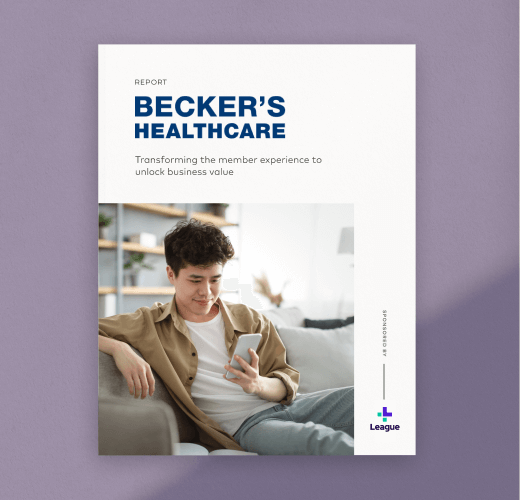Summary
- Customer insights are crucial for successful healthcare CX platforms to understand member needs and enhance their overall experience.
- Having a streamlined digital health platform supports a strategy rooted in both consumer and business value outcomes.
- Track key metrics such as Net Promoter Scores (NPS) and task completion rates to connect improvements in customer experience to tangible gains in both financial and clinical performance.
One of the most challenging hurdles to overcome when beginning consumer experience (CX) transformation initiatives is understanding the value digital health investments will deliver.
But Stacy Byers, Senior Vice President of Experience, Design and Digital at Highmark Health, has been mapping CX transformation to various experience metrics for nearly five years to determine the business value of that work.
In our new report with Becker’s Healthcare, leaders from Highmark Health, Cambia, CCA, and more discuss the principal value drivers of CX transformation and the strategies to deliver value quickly. Within the report, Byers talks about starting the CX transformation journey, how the My Highmark app and web experience enables the health plan to drive business objectives, lessons learned about measuring value and her advice for other executives looking to transform healthcare consumer experiences.
How did you start the journey to develop your CX transformation strategy?
Byers: We spent a lot of time looking at what drives customer value and business value. If you think about that as a Venn diagram, we want to focus our efforts on the things that deliver both. We then looked beneath that at the high-value actions from our perspective.
Task completion is an important example because if a member comes online and can’t complete a task, that person is either going to abandon or make a call. If they abandon, they might decide to defer care or go to a provider out-of-network, which can cause downstream problems. If that member calls, that means we didn’t do a very good job closing the loop. That trains them to go straight to the call center instead of coming online next time. So we started to work through what specific task completions are important, how we are tracking against those, and then use that to inform the evolution of our digital product.
That’s one lens. We also look with a clinical lens. We have robust models for the hard clinical value associated with our diabetes solutions, musculoskeletal programs and others. My Highmark is the one-stop shop to access those solutions. We don’t attribute extra clinical value to the digital experience, but we do say that the digital channel is responsible for getting more people into those programs to derive additional business value.

“CX transformation can’t just be experience for experience’s sake. It has to also help the business deliver what it needs to deliver.”
Stacy Byers
Senior Vice President of Experience, Design and Digital, Highmark Health
How has transforming member experiences with My Highmark enabled you to drive business value?
Byers: For us, there’s a real opportunity to look at what programs are needed most. It’s truly about creating engaging member health experiences that members want to be a part of, want to come back to, and see value in.
That is one of the things we are uniquely able to do with My Highmark because we can prove the value proposition to demonstrate how people are engaging with a particular capability, what we’re seeing in terms of improved use, increased engagement and, ultimately, clinical outcomes. We continue to prove that the model delivers a substantial ROI, as some solutions have been validated by a third party and that’s a storyline: “We can bring value. We have stickiness. We engage with people and deliver outcomes you can’t get from others in this space.”
How does Highmark Health define the value of CX transformation and how are you quantifying and measuring that?
Byers: I have been doing this since 2019, to determine the dollar-for-dollar value of CX transformation and map it to experience metrics. We’re doubling down on the customer and clinician experience, which we measure through Net Promoter Scores (NPS). We map NPS scores to key stages of the journey. That has evolved over time and we now have a robust study that allows us to see opportunities to improve components of the journey that we can then tie to financial or business value.
For example, if we understand that any time a member changes plans it creates a point of friction and that point of friction pops in an NPS survey, we can then recognize the value of guiding members through that transition. Guiding them can mean they’ll contact the call center fewer times because they know exactly what to expect, they know when their ID card is coming, or they download it at the time of enrollment. Having that journey-based mapping to NPS is helping us measure very specifically how actions deliver value for both people and the business.
We are also looking to use an objectives and key results framework to understand how digital can deliver on value drivers. The ‘ease of doing business’ metric, for example, helps with administrative costs, while ‘engaging a member in their own health’ helps us advance our clinical solutions. Another is ‘delivering value to stakeholders.’ We use those internal metrics to bring features to market more quickly, collect feedback, and iterate to deliver high value programs that ensure our customers are seeking those from us, rather than niche competitors.
What lessons have you learned from deploying these metrics?
Byers: It has been really important for us to break the NPS down by our segments, and our markets, and even certain elements of behavior and motivation. We have a model to understand people’s motivation around health and healthcare that allows us to see where the NPS might be higher in one market than another, or we may see real concerns unique to a particular segment. That way, we know where we need to focus. We can also see through that segmentation that we deliver quite well for people already engaged, motivated and even passionate about health, versus people who may be interested in health but face barriers to care. Understanding at that level also helps us identify where we can do a better job serving people based on who they are and how they’re motivated, not just where they live.
What advice would you share with other executives looking to transform the healthcare consumer experience?
Byers: Number one, deeply understand what your specific customers want and need out of their digital journey. Do not make assumptions. Just getting that foundational work together and keeping your eye on the North Star is important because it’s easy to get distracted. Many people have ideas about what you should do and sometimes those ideas aren’t necessarily rooted in customer needs. It’s important to have a strong perspective on what will drive business value but doesn’t necessarily satisfy a consumer need.
Second, CX transformation can’t just be experience for experience’s sake. It has to also help the business deliver what it needs to deliver.
Third, digital transformation requires a lot of change management. It is hard to get people to do things differently. When you think about agile approaches where you can’t guarantee a feature is going to be ready on a certain day, you have to get your sales support teams comfortable with a more flexible approach to committing to the market.
And fourth is the way teams work together. The waterfall approach where the business hands something to a set of developers doesn’t really work in this day and age. Instead, teams need to be joined around customer problems to solve, and that means the team has to represent product, design, technology, data and all of those folks have to have a voice in how to get stuff done.
I really can’t stress enough how important it is to think about transforming the internal culture as you transform your digital experience.
Byers, alongside other health plan executives, see member experience transformation as a massive opportunity to drive greater engagement and achieve business and financial goals for the broader organization.

New research from Becker’s
Gain actionable insights on how to measure the value of your digital CX investments and how to use these investments to win in today’s highly competitive market.
